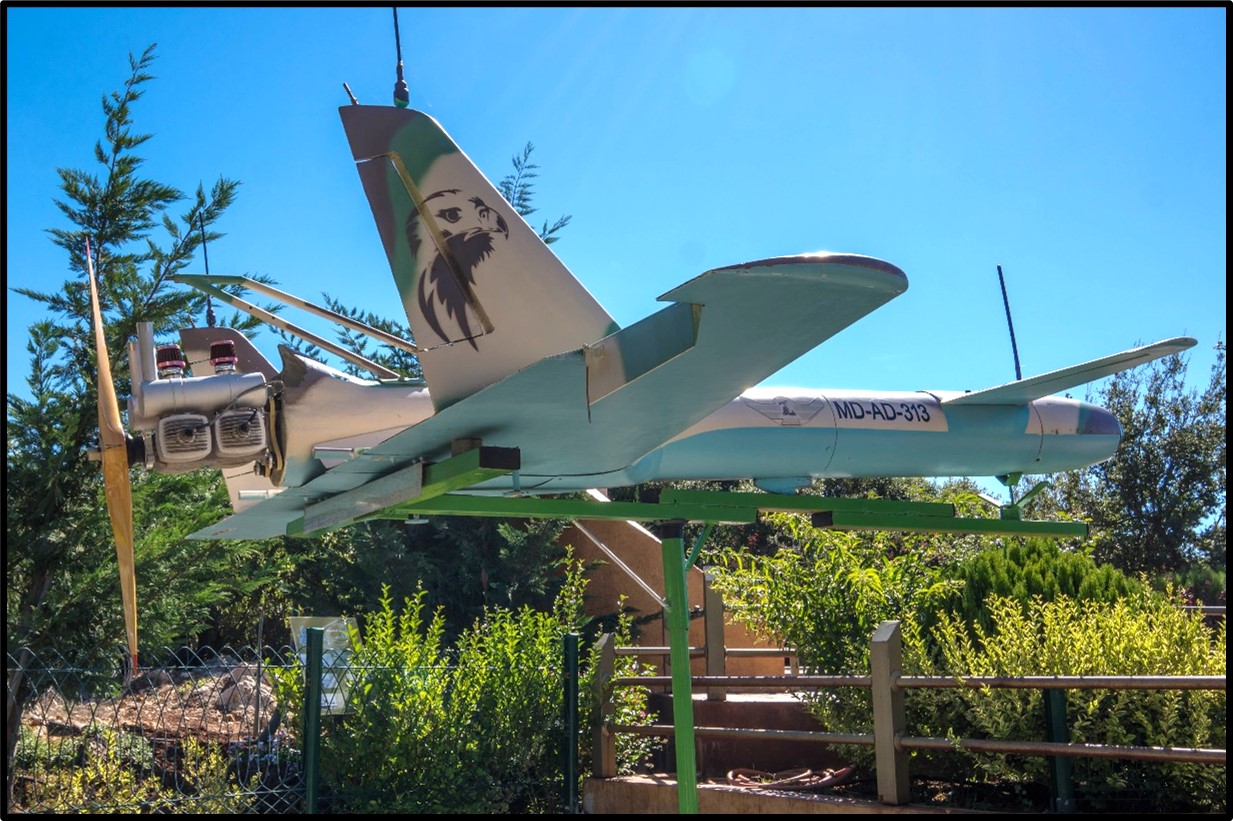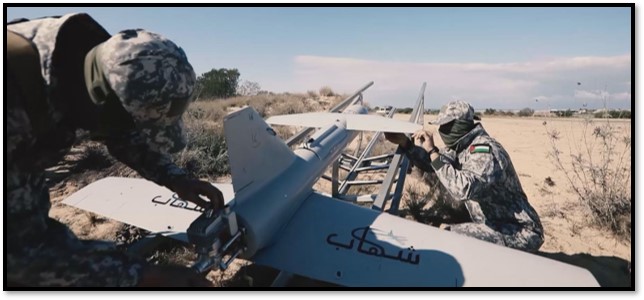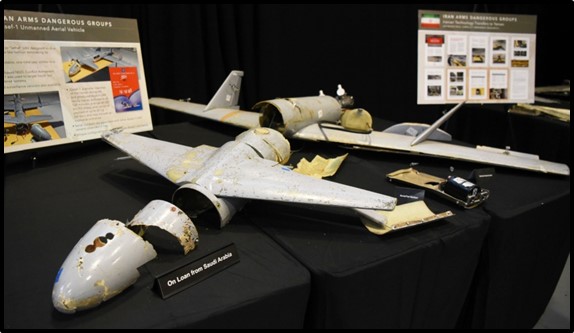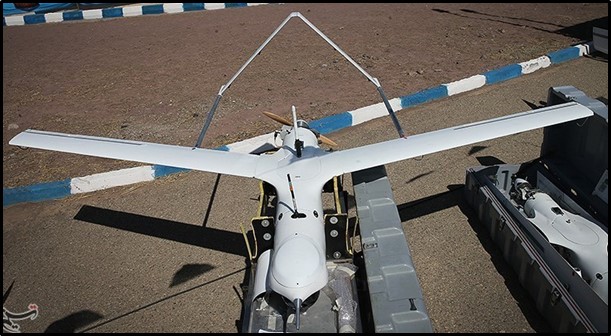Since 2004, Iran has provided drones, components or designs to proxies in at least four locations: Lebanon, Iraq, Yemen, and Gaza. Tehran’s drone exports vary in mission, range, and capabilities. The shortest range can fly only 15 km, or nine miles, while the longest can fly 1,700 km, or 1,000 miles. Some drones, or unmanned aerial vehicles (UAVs), allow Iran’s allies to spy on enemies, while others are used to conduct low-cost kamikaze attacks from a distance. The drones have also allowed Iran to deter attacks beyond its borders by threatening attacks against enemies via proxies. As of mid-2021, Iranian proxies had conducted drone attacks against U.S., Israeli and Saudi forces as well as against jihadi extremists in Syria and Iraq.

In April 2021, Gen. Kenneth McKenzie Jr. warned that the Middle East was becoming a “proving ground for the proliferation and employment of unmanned weaponized systems, many emanating from Iran.” The drone transfers were part of Iran’s asymmetric strategy to compensate for its military weakness. Exporting drones provided Iran with “valuable experience in developing its own systems and in refining tactics, techniques and procedures,” the International Institute for Strategic Studies reported in April 2021. Tehran’s drone transfers have varied in quantity and quality.
- Lebanon: Since 2004, Iran has transferred drones and provided training on flying drones to Hezbollah, the largest militia and a political powerbroker in Lebanon. Hezbollah has used its drones to spy on an Israeli nuclear reactor, ram into an Israeli warship and kill Syrian jihadi fighters. Hezbollah’s drones have ranges of 150 km to 1,700 km, or 93 miles to 1,056 miles, and can carry payloads weighing up to 150 kg (330 pounds).
- Gaza: Since 2012, Iran appears to have provided drone designs to Hamas, a Palestinian militant group based in Gaza that opposes Israel. Hamas drones were based off Iranian designs but built using local materials and expertise. During the 11-day conflict with Israel in May 2021, Hamas deployed a new suicide drone that was similar to an Iranian Ababil-T. Hamas drones have ranges of 150 km to 200 km, or 93 miles to 124 miles, and can carry payloads weighing up to 30 kg (66 pounds).
- Yemen: Since 2016, Iran has transferred drone components and provided training on drones to Houthi rebels who are fighting a civil war and a military campaign led by Saudi Arabia. The Yemeni rebels possess the most advanced and diverse drone arsenal of Iran’s proxies. The Houthis built their drones using a mix of local materials and high-end components reportedly smuggled into Yemen from Iran. The Houthi drones have ranges of 15 km to 1,700 km, or nine miles to 1,056 miles. They can carry payloads of up to 30 kg (66 pounds).
- Iraq: Since 2015, Iran has transferred drones and provided training to at least four Shiite militias in Iraq. Iraqi militias first used drones to spy on the Islamic State in 2015. Since April 2021, Shiite militias have conducted at least six attacks on U.S. and coalition forces using suicide drones. The militias’ drones have ranges of 25 km to 150 km, or 15 miles to 93 miles.
The Revolutionary Guards have also exported drones to Iran’s allies outside of the region, such as Venezuela. The following is a detailed rundown of drone capabilities acquired by Iranian proxies.
Hezbollah (Lebanon)
Hezbollah launched its first unmanned aerial vehicle (UAV) in 2004. Iran reportedly provided the Lebanese militants with drone components and taught them how to fly UAVs remotely. Hezbollah initially used its UAVs exclusively to spy on and attack Israel. But Hezbollah expanded its drone operations into Syria when it joined the civil war on the side of President Bashar al Assad in 2012. As of 2021, Hezbollah’s inventory included:
- The Mirsad-1 is a light-weight drone used for combat and reconnaissance. It is similar to the Ababil-T, which has a range of 150 km to 200 km (93 miles to 124 miles) and can fly for two hours. Its flight ceiling is 3,000 meters (9,800 feet). It can carry a 30 kg (66 pounds) payload. Hezbollah claimed that the Mirsad-1 could carry a payload weighing 40 kg to 50 kg (88 pounds to 110 pounds).
- The Ayoub is a heavy-weight drone used for combat and reconnaissance. It is similar to the Shahed-129, which has an range of at least 1,700 km (1,056 miles) and could fly 15 to 24 hours. Early versions of the Shahed were limited in range due to the need to stay within 200 km (124 miles) from its base of operations. Its flight ceiling is 7,620 meters (25,000 feet). The Shahed-129 could carry a payload weighing up to a 150 kg (330 pounds).
History
In November 2004, the Lebanese Shiite group first launched a Mirsad-1 from southern Lebanon – where its base of support is strongest - into Israeli airspace. The light-weight drone flew over northern Israel to the coastal town of Nahariya, a 20 minute journey, before returning to Lebanon. It was not intercepted by Israeli air defenses. Secretary General Hassan Nasrallah declared that the drone could strike targets “deep” within Israel. “Do you want a power plant, water plant, military base? Anything!” he told supporters at a rally in eastern Lebanon.

Nasrallah denied that Hezbollah had received drone technology from Iran and insisted that his engineers had been working on a secret drone program for several years. “We do not just have one plane, we have enough of them, and we have the capability of building as many planes as we need,” he said in November 2004. But U.S. and Israeli intelligence sources told NBC that Iran had provided Hezbollah with manufacturing components and helped operate them.
In April 2005, Hezbollah again flew the Mirsad-1 into Israeli airspace for an 18-mile round trip spy mission. The drone flew over cities and settlements in the Western Galilee before returning to Lebanon. The small, low-flying aircraft was easily able to avoid detection by Israeli air defenses. “It’s like catching a mosquito with a net,” the Israeli Defense Forces (IDF) chief spokeswoman said.
Between 2005 and 2012, Hezbollah acquired more advanced surveillance drones. In October 2012, the militant group flew an Ayoub drone 35 miles into Israeli airspace to surveil the Dimona nuclear reactor. An Israeli fighter jet shot down the drone but only after the drone had transmitted live images of the plant for three hours. Nasrallah later admitted that the Ayoub drone was designed in Iran and assembled in Lebanon. “We are uncovering a small part of our capabilities, and we shall keep many more hidden,” Nasrallah said on television. By late 2013, Hezbollah reportedly had tens, and potentially hundreds, of Iranian-designed drones.
Hezbollah has also used its drones in combat. During its 2006 war with Israel, Hezbollah launched at least three drones at strategic sites in Israel and rammed an explosive-carrying drone into an Israeli warship. Hezbollah has also used drone attacks against Syrian rebels who opposed President Bashar Assad, a close ally of Iran and the Lebanese militia. Hezbollah operated a secret airbase in northern Lebanon with a runway likely “built for Iranian-made UAVs,” IHS Janes reported in April 2015. In September 2014, the Shiite militants reportedly killed 23 jihadist fighters affiliated with the al Nusra Front in a drone attack. Hezbollah propaganda later showed drones dropping cluster bombs on rebels in Aleppo and even carrying missiles to strike ISIS fighters in Qalamoun.
Hamas (Gaza)
Hamas’s drone program has existed since 2012, but the Gaza-based militants have one of the smaller and less advanced arsenals compared with Iran’s other proxies. Its drones bear a close resemblance to Iranian counterparts but may have been constructed using local materials. Hamas has used its drones to surveil Israeli sites; it launched kamikaze-style drone attacks on Israel in 2014, 2018, 2019 and 2021. As of mid-2021, Hamas’s inventory included:
- The Ababil-1 is a light-weight drone used for combat and reconnaissance. It is similar to the Iranian Sarir H-110, which has a range of 200 km (124 miles) and can fly five hours. Its flight ceiling is 5,000 meters (3 miles).
- The Shehab is a light-weight drone used for combat and reconnaissance. It is similar to the Ababil-T, which has a range of 150 km to 200 km (93 miles to 124 miles) and can fly for two hours. Its flight ceiling is 3,000 meters (9,800 feet). It can carry a 30 kg (66 pounds) payload.
History
In November 2012, the Israeli Defense Force (IDF) released a video allegedly showing Hamas conducting drone flight tests; it was the first indication that the Gaza militants had a nascent drone program. In July 2014, Hamas unveiled three homemade drones: the Ababil-1A for reconnaissance, the Ababil-1B for bombing missions, and the Ababil-1C for kamikaze-style attacks. Analysts said that the drones resembled the Iranian Sarir H-110, which had been displayed in Tehran the previous year. A propaganda video released by Hamas depicted the Ababil-1B carrying four missiles under its wing. The missiles were likely fake, The Aviationist reported.
Hamas testing a UAV
The Hamas drone program faced two major setbacks. The first setback was an Israeli airstrike that hit eight Hamas drone storage facilities. The second setback was the assassination of Mohammed Zawahri, a leading Hamas drone engineer, in December 2016. Zawahri was shot six times at close range by assailants while sitting in his car in Tunisia. The militant Palestinian group blamed Israel for the attack and acknowledged that Zawahri had designed drones for its military wing, the Al Qassam Brigades.
Hamas first employed drones in combat during the 2014 Gaza War. The Sunni militant group said that it flew three drone missions into Israeli airspace, including one mission over Tel Aviv. Israel shot down a drone over Ashdod and another over Ashkelon. Hamas claimed responsibility for the downed drones and said that they had been carrying out “special missions” inside Israel.

Hamas redoubled its efforts to expand its drone program after the 2014 Gaza War. It established an air unit sometime between 2017 and 2018 to operate spy drones, Haaretz reported. In May 2018, it launched at least three drones carrying explosives toward Israel: one landed in the Negev and two landed in the front lawn of a house near the Gaza border. in 2019, Hamas launched at least four separate drone attacks against Israel.
In May 2021, Hamas unveiled a new suicide drone, the Shehab, during a 11-day conflict with Israel. The Shehab was a loitering munition; it could hover near its target and explode near it or on impact. It was the “first instance of a precision-guided munition in Gaza,” said Fabian Hinz, an arms expert. In a propaganda video, Hamas displayed at least four Shehab drones. Analysts said that the Shehab was similar to the Iranian Ababil-T drone or the Houthis’ Qasef-1 drone, although it was smaller in wingspan.
The Houthis (Yemen)
The Houthis have the most advanced and diverse drone arsenal among Iran’s proxies. Iran initially provided the Yemeni rebels with components and designs for combat drones, a United Nations (U.N.) panel of experts reported in January 2018. But the Houthis learned to manufacture drones using a mix of local parts and high-end components smuggled into Yemen from abroad, the same panel reported in January 2020. The Houthis have employed drones in tens of kamikaze-style attacks against Saudi Arabia. They also claimed a drone strike on the United Arab Emirates, although the UAE denied any attack. As of 2021, the Houthi inventory included:
- The Qasef-1/Qasef-2K is a medium drone used for combat It is similar to the Ababil-T, which has a range of 150 km to 200 km (93 miles to 124 miles) and can fly for two hours. Its flight ceiling is 3,000 meters (9,800 feet). It can carry a 30 kg (66 pounds) payload.
- The Raqib is a light-weight drone use for reconnaissance. It has a range of 30 km (19 miles) and can fly two hours. It has no direct Iranian equivalent.
- The Rased is a light-weight drone use for reconnaissance. It has a range of 35 km (22 miles) and can fly two hours. It is similar to a Chinese-made Skywalker 8-X, which can fly for 25 minutes. Its flight ceiling is 200 meters (656 feet).
- The Hudhud-1 is a light-weight drone use for reconnaissance. It might have been indigenously developed in Yemen, the United Nations reported in 2018. It has a range of 15 km (9 miles) and can fly 98 minutes.
- The Sammad-1 is a reconnaissance drone. It has a range of 500 km (310 miles). It has no direct Iranian equivalent.
- The Sammad-2 is a combat drone. It has a range of 1,300 km (807 miles). It has no direct Iranian equivalent.
- The Sammad-3 is stealth combat drone. It has a range of 1,700 km (1,056 miles). It has no direct Iranian equivalent.
History
In December 2015, the Houthis flew their first drone: a commercial quadcopter stolen from a local television station. The drone took an aerial picture of a crowd in Sanaa celebrating the Islamic Prophet Muhammad’s birthday. In 2016, the Houthis began using drones for reconnaissance over the strategic Marib province, the International Institute for Strategic Studies reported. Pro-government forces intercepted at least six spy drones from late 2016 to early 2017.

In February 2017, the Houthis unveiled four drones that they claimed were designed and manufactured indigenously “by a group of creative mujahideen who overcame various difficulties and obstacles.” Three UAVs - the Hudhud-1, the Rased and the Raqib –were light reconnaissance drones. The fourth – the Qasef-1 – was the first combat drone used by the Houthis. In January 2018, the U.N. Panel of Experts on Yemen concluded that the Qasef-1 is “virtually identical in design, dimensions and capability” to Iran’s Ababil-T. The panel also concluded that the materials needed to assemble the drone “emanated from the Islamic Republic of Iran.”
In July 2019, the Houthis unveiled the Qasef-2K, which they claimed was an improved variant of the Qasef-1. But the Houthis did not specify how the Qasef-2K differs from the older generation of Qasef-1s. The two models were “nearly identical in design,” Conflict Armament Research reported in February 2020. Qasef drones carried explosives to conduct kamikaze style attacks. But their limited range “did not allow for strikes beyond Yemen and the southern border regions of Saudi Arabia,” the U.N. panel reported in January 2019. By 2020, the Houthis were able to manufacture the fuselage and wings of Qasef drones using locally available materials, while sourcing high-value components (such as engines) from abroad, the United Nations reported.
The Houthis have launched multiple attacks against Saudi Arabia using Qasef drones. In 2017, Qasef-1s were used to attack Saudi missile defense systems and damage their radar, Conflict Armament Research reported. In 2019, Qasef-2Ks were used in attacks against Saudi cities, an arms depot and at least two airports, according to pro-Houthi media. In January 2019, the Houthis attacked a military parade at the Anad airbase using a Qasef-2K drone, the United Nations reported. Five pro-government soldiers were killed and at least 20 others were wounded, including several high ranking military officials. In May 2021, the Houthis attacked King Khalid Airbase at least three times using Qasef-2K drones.
Here we go: The Samad-3 drone with the Samad-1 ("UAV-X") behind it. pic.twitter.com/Y7FDaYAu1X
— Tobias Schneider (@tobiaschneider) July 7, 2019
In September 2019, the Houthis unveiled a new drone class named the Sammad, which had three variants, Press TV reported. The Sammad-1 was a reconnaissance drone with a range of 500 km (310 miles). The Sammad-2 was a combat drone with a range of 1,300 km (807 miles) capable of “performing tactical and stealth maneuvers.” The Sammad-3 was a stealth combat drone with a range of 1,700 km (1056 miles) capable of kamikaze attacks. Sammad drones were powered by 3W-100i B2 engines that were shipped to a company in Iran by a German manufacturer, the U.N. panel reported in January 2020.
Sammad drones appeared to be used less frequently than Qasef drones, but they featured heavily in Houthi propaganda. In summer 2018, the Houthis claimed that they attacked the Abu Dhabi and Dubai airports using the Sammad-3, although the UAE denied that any attacks occurred. In September 2019, the Yemeni rebels claimed that they fired Sammad-3 drones at the Abqaiq oil facility. In March 2020, a military spokesperson said that the Houthis hit “sensitive” sites in Riyadh with Sammad-3 drones. In March 2021, pro-Houthi media reported that six Sammad-3s were used to strike an oil facility in Riyadh.
Popular Mobilization Forces (Iraq)
Iran-backed militias are relative newcomers to drone technology but launched at least six drone attacks on U.S. and coalition forces in Iraq between April and June 2021. At least four Iraqi militias – the Badr Brigades, Kataib Hezbollah, Kataib Jund al Imam and Harakat Hezbollah al Nujaba – have demonstrated drone capabilities. As of 2021, Iraqi militia arsenals included:
- The Oghab-1 is a light-weight drone used for reconnaissance. It is manufactured by Farnas Pasargad, an Iranian company. It has a range of 25 km (15.5 miles) and can fly for 45 minutes.
- The Yasir is a light-weight drone used for reconnaissance. It is manufactured by Iran Aviation Industries Organization. It is identical to the Iranian Yasir, which has a range of 200 km (124 miles) and can fly for 8 hours.
- The Basir-1 is a medium-weight drone used for surveillance and combat. It is similar to the Iranian Ababil-3, which has a range of 100 km to 150 km (62 to 93 miles) and can fly for up to four hours.
History
In 2015, the Badr Brigades – Iran’s oldest militia proxy in Iraq – were the first to claim a drone arsenal. In February 2015, a Badr leader in Baghdad, said that Iran had provided the militants with UAVs and taught them how to make them. “The [PMF], with the help of (Iranian) advisers, now knows how to operate and manufacture drones,” he told Reuters. In March 2015, a Kataib Hezbollah spokesperson told an Iraqi TV channel that the Shiite militia had flown Basir-1 drones – which appeared to be similar to the Iranian Ababil-3 – over Tikrit to spy on Islamic State fighters.

In May 2015, Badr published photos of a reconnaissance drone later identified as the Oghab-1; the drone was manufactured by Farnas Pasargad, an Iranian company. The same month, Kataib Jund al Imam posted a video featuring a Yasir drone, an Iranian drone that was reverse engineered from a Boeing ScanEagle; Iran captured the U.S. ScanEagle in December 2012 while it was conducting a reconnaissance flight over the Persian Gulf. In June 2017, a spokesman from Harakat Hezbollah al Nujaba told a Swiss security policy blog that it possessed six drones modelled on the Yasir. A Kataib Hezbollah fighter told the same website that the militia had used drones during the liberation of Fallujah from the Islamic State in May 2016. “The Iranian drones allow us to distinguish between civilian areas and ISIS areas,” the militiaman said.
For years, Iraqi militias used Katyusha rockets to fire on U.S. forces and diplomatic targets. But starting in early 2021, they began launching kamikaze drone attacks against U.S. forces. From April to June 2021, Iraqi militias conducted at least six drone attacks on American targets. They included:
- On April 14, a drone carrying explosives targeted a CIA hangar inside the complex at Erbil International Airport in northern Iraq. No casualties were reported.
- On May 8, a drone attacked Ain al Asad Air Base in central Iraq. No casualties were reported.
- On June 6, Iraqi air defenses shot down two drones that approached Ain al Assad. No casualties were reported.
- On June 9, three drones attacked the Baghdad Diplomatic Support Center near the Baghdad airport, the Iraqi military reported. One drone was shot down. No casualties were reported.
- On June 15, Iraqi air defense shot down two drones, one in Baghdad and one in a nearby suburb, the Iraqi military reported. No casualties were reported.
- On June 26, three drones carrying explosives hit a house near the new location of the U.S. Consulate in Erbil. Another drone landed in an unpopulated area. No casualties were reported.
In May 2021, U.S. officials expressed alarm over the growing rate of drone attacks, which were too small and flew too low to be intercepted by U.S. air defenses, the Washington Post reported. On June 27, the Biden administration conducted a retaliatory strike against two Iraqi militias—Kataib Hezbollah and Kataib Sayyid al Shuhada—that it blamed for attacks against U.S. forces in Iraq.
Photo credits: Mirsad-1 by Frode Bjorshol via Flickr (CC by 2.0); Shehab via Hamas video; Qasef-1 by Lisa Ferdinando via DVIDs (Public Domain); Ababil-3 via Fars News Agency (CC by 4.0); Yasir via Tasnim News Agency (CC by 4.0)
